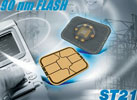Secure MCU employs cutting-edge process
23 January 2008
DSP, Micros & Memory

STMicroelectronics has developed a new secure microcontroller (MCU) based on embedded Flash memory, which the company says is the first in the world to be produced using 90 nm process technology. The ST21F384 - the first secure MCU within ST's established ST21 smartcard platform, optimised for 2,5G and 3G mobile communications - uses Flash memory in place of mask ROM for its program memory, to provide increased flexibility and shorter lead times for manufacturers, coupled with increased cost-efficiency from its 90 nm production.
The new ST21F family will enable card manufacturers to react quickly and cost-effectively to the fast changing needs of the mobile market, customising applications late in the production process, at the card personalisation stage, and addressing the requirements of multiple mobile network operators (MNOs) with a single product. Supply chain risk and complexity can be reduced, as the silicon is not linked to a specific operator profile.
The ST21F384 is based on an enhanced 8/16-bit CPU core with 16 MByte linear addressing range, running typically at 21 MHz. It embeds 7 KBytes of user RAM, plus 384 KBytes of Flash memory, with an erase capability similar to that of the EEPROM used in earlier devices in the secure family. Current consumption complies with 2G and 3G specifications to meet the requirements of (U)SIM applications. The microcontroller includes a hardware DES (Data Encryption Standard) accelerator and a user-accessible CRC (Cyclic Redundancy Code) calculation block.
Further reading:
Memory for asset tracking
Altron Arrow
DSP, Micros & Memory
The Page EEPROM, ST’s latest memory, has been designed for efficient datalogging and fast firmware upload/download in battery-operated devices.
Read more...
Engineered for high-reliability applications
Future Electronics
DSP, Micros & Memory
The MCX E series of Arm Cortex-M4F and Arm Cortex-M7 microcontrollers from NXP are engineered for demanding industrial and IoT environments.
Read more...
NXP’s development platform guide
DSP, Micros & Memory
Choosing between the FRDM i.MX 93, FRDM i.MX 91 and FRDM i.MX 91S development platforms can be intimidating, but once designers understand how each platform aligns with their application’s requirements, the decision becomes straightforward.
Read more...
XJTAG launches two new Flash programmers
ASIC Design Services
DSP, Micros & Memory
XJTAG has announced XJExpress and XJExpress-FPGA, a pair of Flash programmers perfect for development, debug and in-service applications.
Read more...
Processor offers competitive solution for advanced HMIs
Future Electronics
DSP, Micros & Memory
The new RZ/A3M microprocessor from Renesas features 128 Mbytes of fast DDR3L DRAM memory for system cost reduction, and supports
1280 x 800 px video resolution at a rate of 30 frames/s.
Read more...
ESP32-C6 achieves PSA-L2
iCorp Technologies
DSP, Micros & Memory
Espressif Systems recently announced that its ESP32-C6 microcontroller has achieved PSA Certified Level 2 (PSA-L2) security certification, making it the first RISC-V-based MCU to reach this level.
Read more...
Microprocessor with integrated NPU
Avnet Silica
DSP, Micros & Memory
The RZ/G3E from Renesas is a microprocessor integrated with quad CPU and NPU in one chip, improving power efficiency, reliability, and security.
Read more...
Nordic Semiconductor launches nRF Connect SDK Bare Metal option for nRF54L series
Avnet Silica
DSP, Micros & Memory
This is a new, RTOS-independent software solution for Bluetooth LE development, designed to ease developers’ migration from the legacy nRF5 SDK and nRF52 series to the next-generation nRF54L series.
Read more...
Dual-core support in NECTO Studio
DSP, Micros & Memory
MIKROE recently announced that version 7.3.0 of its NECTO Studio Integrated Development Environment now supports dual-core MCUs, allowing designers to program and debug each core independently.
Read more...
Post Quantum Cryptographic firmware library
DSP, Micros & Memory
The STM32 post-quantum cryptographic library enables developers to satisfy application requirements for any combination of data integrity, confidentiality, identification/authentication, and nonrepudiation.
Read more...


